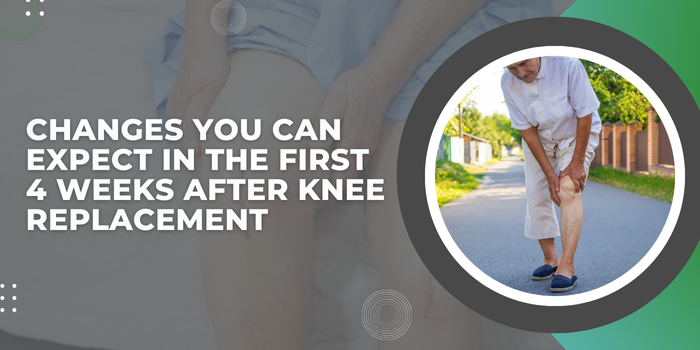“Healthy knees are the foundation of a strong and active life.” Yet, millions worldwide suffer from knee problems, making daily movements difficult. According to global health statistics, over 600,000 knee replacement surgeries are performed annually, offering relief to those struggling with joint pain and stiffness.
Dr. Sandeep Singh, a trusted orthopedic doctor in Bhubaneswar, states, “Knee conditions can impact mobility, independence, and overall quality of life. Fortunately, advancements in knee replacement techniques have made recovery more efficient and predictable, helping patients regain normal function.”

Common Changes 4 Weeks After Knee Replacement

Reduced Swelling and Bruising: Swelling may still be present but should be noticeably less than the first two weeks. Keeping the leg elevated and using ice therapy helps.
Improved Range of Motion: Bending and straightening the knee becomes more effortless, although stiffness may still be present.
Decreased Pain Levels: Pain gradually subsides, but occasional discomfort is common, especially after prolonged sitting or activity.
Better Stability and Balance: Regular physical therapy makes walking steadier, often with reduced dependence on walking aids.
Increased Activity Levels: Patients can perform daily tasks more easily, but high-impact activities are still discouraged.
Experiencing unexpected challenges during recovery? Consulting an orthopedic specialist can help you navigate this phase with the right guidance and care. Book An Appointment!
Are Pain and Swelling Normal During the Initial Recovery Period?

Mild pain and swelling are still common four weeks post-surgery. The body continues to heal, and movement increases, which can occasionally trigger discomfort.
Dr. Sandeep Singh, an experienced orthopedic surgeon in Bhubaneswar, explains, “Pain management is crucial for a smooth recovery. Patients should adhere to prescribed medications and avoid overexertion. Swelling can fluctuate based on activity levels, so adequate rest and periodic elevation of the leg are essential. Listening to your body and pacing activities can prevent unnecessary strain, ensuring steady progress.”
With over 15 years of expertise, Dr. Singh is a highly sought-after surgeon for Knee Replacement in Bhubaneswar.
Managing discomfort is essential, but what about potential complications? Let’s explore precautions to take in the early weeks.
Precautionary Steps To Avoid Complications

Taking proper precautions can prevent setbacks and promote better healing.
Avoid Excessive Strain: Overexerting the knee can cause inflammation and delay healing. Stick to the recommended activity levels.
Follow Prescribed Exercises: Physical therapy is essential for regaining strength and mobility. Skipping sessions can slow progress.
Maintain Proper Posture: Sitting for too long or bending the knee incorrectly may cause stiffness and discomfort.
Monitor for Infections: Redness, warmth, or unusual drainage from the incision site should be reported to a doctor immediately.
Stay Hydrated and Eat Well: Proper nutrition supports tissue repair and overall recovery.
Let’s discuss ways to regain strength and mobility safely.
How Can You Improve Mobility and Strength Safely During the First Month?

Rebuilding mobility and strength should be gradual. Here’s how to do it safely:
Engage in Low-Impact Exercises: Walking, stretching, and light stationary cycling can enhance joint flexibility.
Use Assistive Devices as Needed: If advised, continue using crutches or a walker to prevent strain on the healing knee.
Perform Strength Training: Leg raises and ankle pumps can strengthen surrounding muscles, improving knee stability.
Follow a Consistent Routine: Doing exercises regularly, without overdoing them, leads to steady improvement.
Listen to Your Body: Avoid movements that cause sharp pain and consult a doctor if discomfort persists.
Follow-up with your doctor: Regular follow-ups with your doctor ensure that your recovery is on track, allowing for necessary adjustments in your rehabilitation plan to improve mobility and strength safely.
Conclusion
Knee replacement surgery has transformed the lives of many patients, allowing them to regain independence and mobility. The recovery process requires patience, but significant improvements are noticeable within the first four weeks with the right care.
Dr. Sandeep Singh, a seasoned Orthopedic Doctor in Bhubaneswar, affirms,
“Medical advancements have made knee replacement surgeries more effective, ensuring better long-term outcomes. With guided post-surgery care, patients can look forward to a stronger and healthier future. Every step forward in recovery is progress—stay positive, stay committed, and trust the process.”
Have more questions about recovery? Let’s answer some of the most common concerns patients have.
Frequently Asked Questions:
When can I start walking without assistance after knee replacement?
Can I drive after 4 weeks of knee replacement surgery?
How long should I continue physical therapy?
Physical therapy typically lasts 6-8 weeks to restore mobility, strength, and joint function. Some individuals may require longer sessions depending on their recovery progress. Your orthopedic specialist will determine the appropriate duration based on your improvement.
Is it normal to feel stiffness in the knee at this stage?
Yes, mild stiffness is common during the early recovery period and should improve with regular movement and exercises. Stretching and physiotherapy help reduce stiffness and enhance flexibility. However, if stiffness worsens or limits mobility, seek medical advice.
What should I do if I experience clicking sounds in my knee?
Clicking sounds are a normal part of the healing process as the artificial joint adjusts to movement. They usually decrease over time as muscles strengthen and the knee stabilizes. If the clicking is persistent, painful, or accompanied by swelling, consult your doctor for an evaluation.
Reference Links:
https://www.mayoclinic.org/tests-procedures/knee-replacement/about/pac-20385276
https://orthoinfo.aaos.org/en/treatment/total-knee-replacement/
Disclaimer: The information shared in this content is for educational purposes only and not for promotional use.

